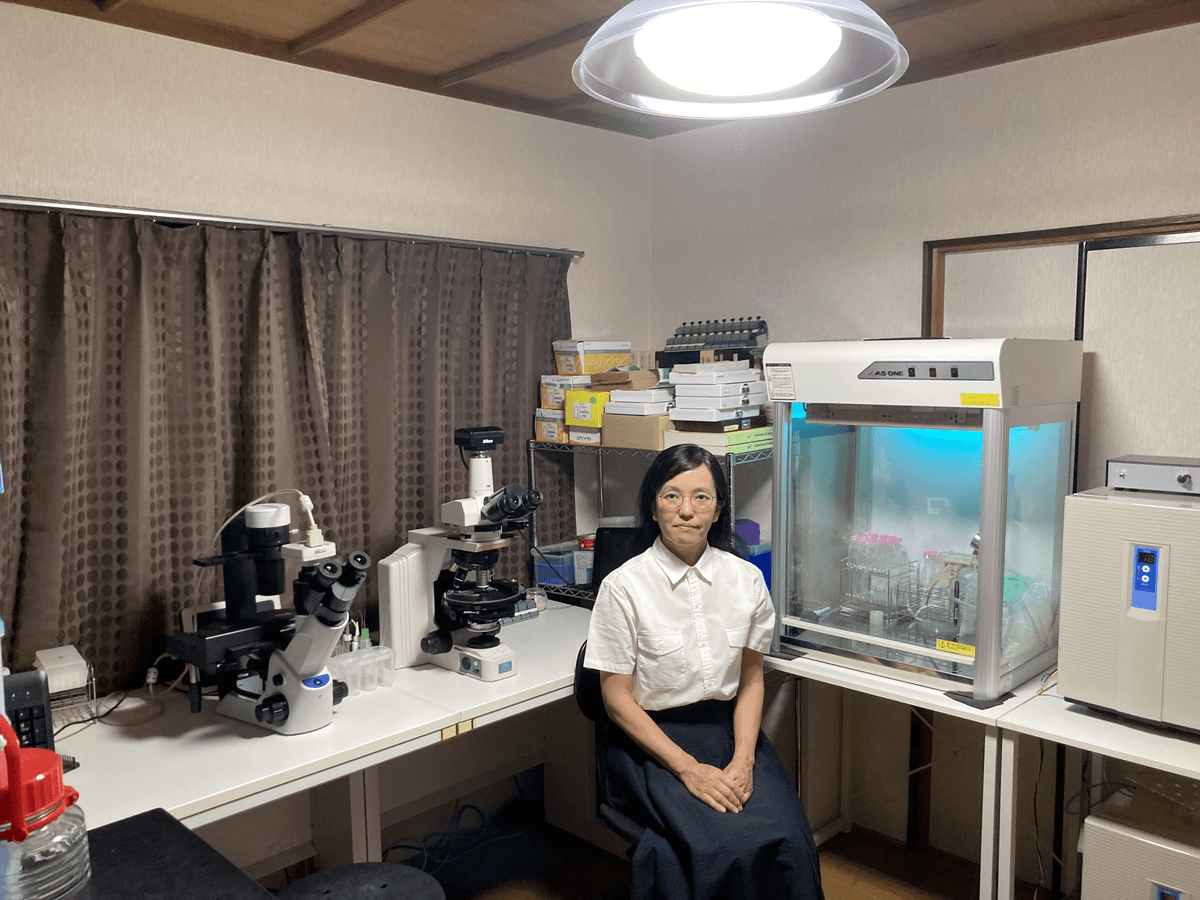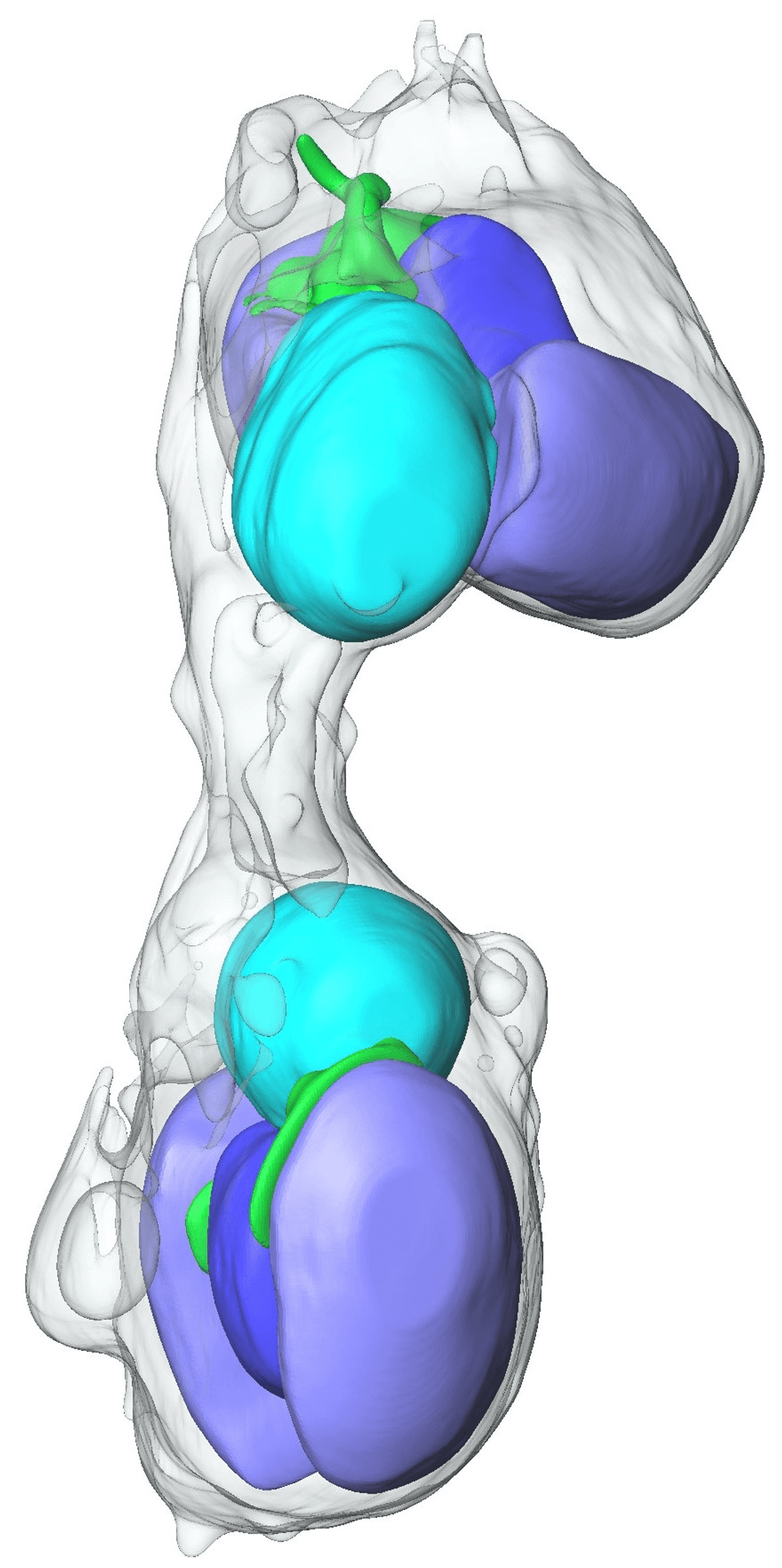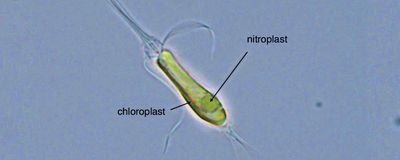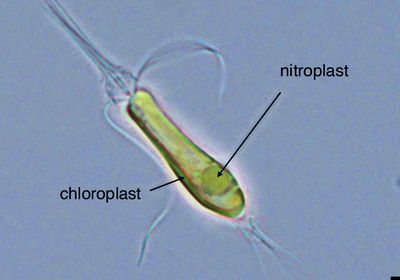ABOVE: Researchers have identified a nitrogen-fixing organelle known as a nitroplast. Here, it is seen at the opposite end of flagella in this light micrograph image, in the marine alga Braarudosphaera bigelowii. Kyoko Hagino-Tomioka
Most organisms require nitrogen to produce biological molecules, such as nucleotides and amino acids, but until recently, only prokaryotes were known to fix nitrogen from the atmosphere.
In a recent Science article, marine microbiologist Tyler Coale of the University of California, Santa Cruz turned this theory on its head.1 Coale and his colleagues revealed an organelle, the nitroplast, in the eukaryotic marine alga Braarudosphaera bigelowii that fixes nitrogen.
“It’s a very interesting paper,” said Verena Kreichbaumer, a plant cell biologist at Oxford Brookes University who was not involved in the study. “It’s solid science based on a lot of controls.”
The researchers did not start out looking for a new organelle. Years ago, John Zehr, a marine microbiologist at the University of California, Santa Cruz and coauthor of the study, was interested in how marine microorganisms acquire and use nitrogen. Combing the oceans for microorganisms with DNA sequences homologous to nitrogenase, the large enzyme that fixes nitrogen, Zehr found many sequence variants. One of them, from cyanobacteria Candidatus Atelocyanobacterium Thalassa (UCYN-A), was geographically widespread. At that time, Zehr and his team sequenced its entire genome and found that UCYN-A was associated with the marine alga, B. bigelowii.2 Coale, who is currently a postdoctoral fellow in Zehr’s lab, said, “They just assumed UCYN-A was a symbiont. It doesn't have the genes to make proteins, to make amino acids and DNA, to make basic things that all cells need.”
Symbionts are common in nature. But until now, only three are known to have evolved into organelles. The chloroplast and the chromatophore of Paulinella chromatophora, are considered to have descended from different orders of photosynthetic cyanobacteria, whereas the mitochondrion is thought to be a descendent of a photosynthetic purple bacterium.3–5
Coale and his colleagues wanted to determine whether UCYN-A behaved as an endosymbiont or had evolved into an organelle. The advanced studies needed to find this out necessitated growing B. bigelowii in culture. Fortunately, evolutionary biologist Kyoko Hagino-Tomioka of Kochi University, a coauthor of the article, had been collecting B. bigelowii from the coastal waters of Japan and studying their motile and non-motile phases for years. Interested in the crystal structures they produce, she had learned to culture these organisms over ten years in her home laboratory (as a guest lecturer, Hagino-Tomioka did not have access to the university laboratory).6 “It was a labor of love and she had no idea where it was heading,” said Coale.

Once the hurdle of culturing B. bigelowii was crossed, Carolyn Larabell, a biophysicist at Lawrence Berkeley National Laboratory and a coauthor of the study, got to work. She and her team used soft X-ray tomography to visualize UCYN-A inside B. bigelowii. The team noticed in the tomographs that the mitochondrion wrapped around UCYN-A. “It's not just the classic bean-shaped mitochondria you see in a textbook,” Coale said. Instead, it hugged UCYN-A as if to deliver ATP directly for nitrogen fixation, according to Coale.
They also saw that UCYN-A divided in synchrony with other organelles, a piece of data that contributed to their determination that UCYN-A was a true organelle.

Further evidence that UCYN-A behaves as an organelle came from studies of its proteome. Cellular organelles that were once endosymbionts have reduced genomes. They lose their own genes over time because they acquire so many of their proteins as a result of nuclear encoded genes. Coale’s proteomic studies revealed that UCYN-A acquired its proteins from B. bigelowii for essential functions like amino acid and pyrimidine biosynthesis and for nitrogen fixation. “Seeing flavodoxin in there was really surprising,” Coale said. Flavodoxin is a redox protein for nitrogen fixation in many organisms. Its import from the cytoplasm suggests that UCYN-A does not carry out nitrogen fixation independently. “I've tried to get it to fix nitrogen on its own,” Coale said. “It's a hard thing to show one way or the other, but I've had no success.”
Proteins destined for the mitochondria or chloroplasts, or for the chromatophore of the amoeba, Paulinella chromatophora, are known to contain transit sequences that direct the protein to its destination.7 Coale found that the nuclear-encoded proteins destined for UCYN-A also contained additional amino acids. Scientists use the lengths of transit peptides to determine how long ago an organelle evolved from an endosymbiont. For example, those of proteins destined for mitochondria and chloroplasts are extremely short, just a few amino acids. This suggests a long evolution time during which their length has been pared down as they become optimized for function. Mitochondria and chloroplasts are thought to be over one billion years old. In contrast, the transit sequences of UCYN-A and the chromatophore of Paulinella are only 100 amino acids long, suggesting they are younger organelles, perhaps only 100 million years of age.
“We now know much more about the kind of biochemistry that’s possible in this organelle,” Coale said, “and how it’s integrated with the rest of the cell’s metabolism.”
- Coale TH, et al. Nitrogen-fixing organelle in a marine alga. Science. 2024;384(6692):217-222.
- Thompson AW, et al. Unicellular cyanobacterium symbiotic with a single-celled eukaryotic alga.Science. 2012;337(6101):1546-1550.
- Gray MW, The evolutionary origins of organelles.Trends Genet. 1989;5:294-299.
- Nakayama T, Ken-ichiro I. Another acquisition of a primary photosynthetic organelle is underway in Paulinella chromatophora. Curr Biol. 2009;19(7):PR284-R285.
- Cavalier-Smith T. Origin of mitochondria by intracellular enslavement of a photosynthetic purple bacterium. Proc R Soc B. 2006;273(1596):1943-1952.
- Hagino-Tomioka K, et al. Seasonal succession of living coccolithophores in the coastal waters of Tomari Port, Tottori, Japan.J Nannoplankton Res. 2019;4:1-15.
- Singer A, et al. Massive protein import into the early-evolutionary-stage photosynthetic organelle of the amoeba Paulinella chromatophora. Curr Biol. 2017;27(18); P2763-2773.e5.




